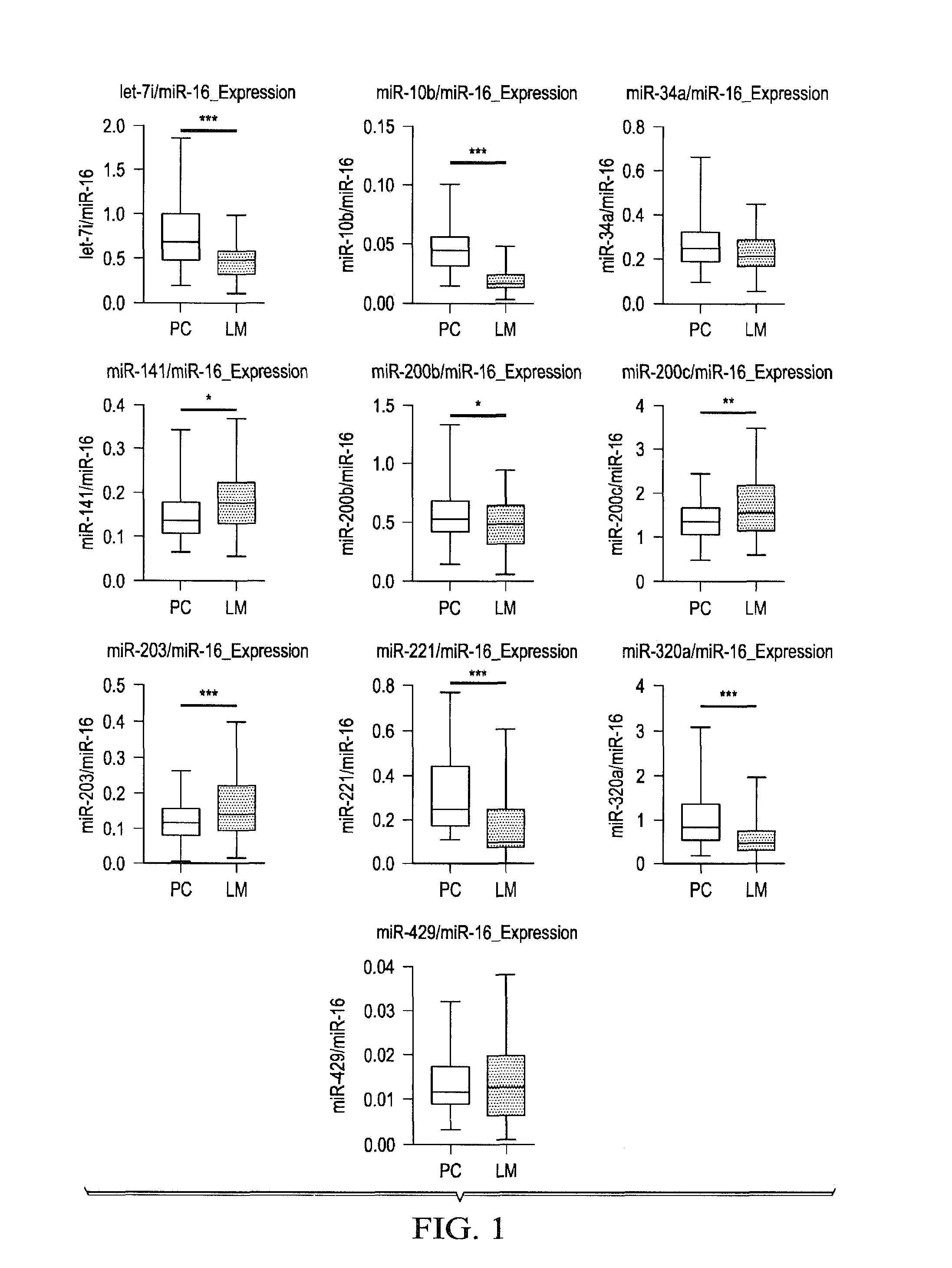Tissue & blood-based mirna biomarkers for the diagnosis, prognosis and metastasis-predictive potential in colorectal cancer
a biomarker and colorectal cancer technology, applied in the field of cancer, can solve the problems of overtreatment of patients with toxic agents that produce severe adverse effects, affecting the prognosis and survival rate of colorectal cancer, and death of patients
- Summary
- Abstract
- Description
- Claims
- Application Information
AI Technical Summary
Benefits of technology
Problems solved by technology
Method used
Image
Examples
example 1
Identification of Metastasis-Related miRNAs
Materials and Methods
[0282]A commercially available kit for miRNA extraction from cell lines, Formalin-Fixed, Paraffin-Embedded (FFPE) tissue, and human serum samples with some modifications. To compare miRNAs expression status between primary CRC and distant metastasized CRC, expression of fourteen metastasis-related miRNAs (let-7i, miR-10b, miR-30b, miR-34a, miR-141, miR-200b, miR-200c, miR-203, miR-221, miR-320a, miR-373, miR-429, miR-518d, and miR-520c) was analyzed in matched primary colorectal cancer and corresponding liver metastasis tissues from 59 patients. MicroRNA expression levels were determined by quantitative real-time PCR (qRT-PCR) and the data were normalized relative to miR-16 expression. The skilled artisan will recognize, however, that many different methods for determining expression can be used with certain aspects of the present invention, e.g., thin layer chromatography (TLC), high performance liquid chromatography (...
example 2
Identification of a Metastasis-Specific miRNA Signature in Human Colorectal Cancer
[0318]A metastasis-specific miRNA biomarker discovery approach was developed that involved comprehensive miRNA expression profiling of both primary CRC (pCRC) and matched liver metastasis (LM) tissues, followed by validation of these newly discovered miRNA biomarkers in multiple, large, independent cohorts of tissues. The expression patterns of these miRNAs was correlated with important clinicopathological parameters related to CRC metastasis. The feasibility of these miRNAs as tissue-based and serum-based metastasis-specific biomarkers was also evaluated.
[0319]Methods
[0320]Patient Samples.
[0321]This study utilized 477 tissue specimens including 326 pCRCs, 67 matched corresponding LMs, and 84 adjacent non-tumor colonic tissues from 5 different CRC patient cohorts that are described in Table 9. In addition, 169 serum samples from CRC patients were also analyzed
TABLE 9Characteristics of All Patients from...
example 3
Serum miR-21 as a Promising Biomarkers for the Early Detection and Prognosis of Colorectal Cancer
Materials and Methods
[0352]Study Design
[0353]The present study included analysis of 568 serum and tissue specimens that were obtained from healthy volunteers and consecutively enrolled patients with colorectal adenomas and cancers, at the Mie University Medical Hospital, Japan, between Jan. 1, 2005 and Dec. 31, 2010. This study was designed as an initial screening phase and a subsequent validation phase. In the screening phase, oncogenic miR-21 and miR-31 were selected (Meng 2007; Zhu 2007; Asangani 2008; Wang 2009; Cottonham 2008), and their expression was measured usmg TaqMan-based quantitative RT-PCR (qRT-PCR) using cell culture medium and matched serum and tissue samples. To determine the secretory potential of these miRNAs, two CRC cell lines, HCT 116 and SW620, were cultured and a fraction of culture medium was collected at 0, 24 and 48 h after the initial seeding of cells in 10 cm...
PUM
| Property | Measurement | Unit |
|---|---|---|
| temperatures | aaaaa | aaaaa |
| temperatures | aaaaa | aaaaa |
| temperature | aaaaa | aaaaa |
Abstract
Description
Claims
Application Information
 Login to View More
Login to View More - R&D
- Intellectual Property
- Life Sciences
- Materials
- Tech Scout
- Unparalleled Data Quality
- Higher Quality Content
- 60% Fewer Hallucinations
Browse by: Latest US Patents, China's latest patents, Technical Efficacy Thesaurus, Application Domain, Technology Topic, Popular Technical Reports.
© 2025 PatSnap. All rights reserved.Legal|Privacy policy|Modern Slavery Act Transparency Statement|Sitemap|About US| Contact US: help@patsnap.com



